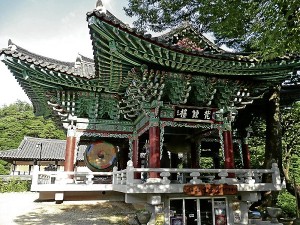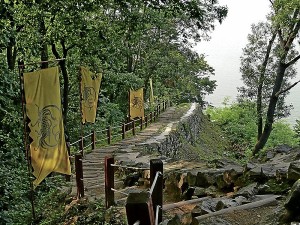
South Korea must be the best country in the world to be homeless. Perhaps that is not something you would read in a Lonely Planet, and it is doubtful that South Korean tourism authorities would include that information in their next 30-second spot on cable news.
Nonetheless, you have to love a country where it is socially acceptable to bring a sleeping mat to a public place, like a park or a parking lot, and snore loudly in cadence to the sound of crickets.
I watched a Radiohead concert an hour out of the South Korean capital and almost tripped over a couple who had sunk into a slumber on something not that much different from a banig. Never mind the fact that they chose to sleep during Radiohead’s set (I know people who would have traded their liver for a ticket to that show). They did it in an open field while drunken people milled around like they just spent an hour on a roller coaster.

An Australian woman commented that in her country they would have been trampled to death.
The first time I saw this Korean quirk (which may very well be acceptable only during music festivals and cultural events) was in a place called Boryeong.
I timed my visit to the city’s Daecheon Beach during the annual Mud Festival, a decision I liked and regretted with equal vigor. I have traveled around East Asia often enough to know that anything popular that only happens once a year would be a magnet for drunk and rowdy expats. This is not to say that I don’t get drunk and rowdy myself. I can drop it like it’s hot or whatever the kids say these days.
My main problem with weekend-long, brain cell genocide is, oddly, the need for some foresight.
In the case of Boryeong, decent lodging within walking distance of the Mud Festival is fully booked months in advance, usually at three times the normal rate. People who have weaker planning acumen usually end up staying in a minbak, which is Korean code for foreigner paying $80 to sleep on the floor.
It was such a surprise that people who would willingly wrestle in mud miles away from a strip club failed to secure decent shelter. On grassy strips of landscaping and on park benches, people dozed off like their own mothers rocked them to sleep.

What was exceptional wasn’t the fact that they slept like they were at home, it was that people left them alone. Nobody tried to rob or molest them. Nobody shrugged their shoulders and talked about the decline of civilization. People were tolerant; this is a trait I have found to be endemic among South Koreans.
I realize that there must have been a spike in the number of out-of-towners, but the fuss was really nice to allow temporary vagrancy.
The sweet spot
I am not a world traveler, at least not yet. I am more of an Asian travel major with a minor in European beer drinking. I say this to stress the point that I am at a stage where things still surprise me— that sweet spot between wide-eyed and jaded.
I know that most tours are unnecessary and that I can get to places on my own cheaply. I consider it a source of pride that I can figure out the Tokyo subway and that I was able to go from Beijing to the Great Wall for less than 50 pesos.
Despite my confidence in my ability to get around strange places, I recognize that the universe just wants to punch me in the face sometimes. I planned on taking the last bus to my hostel in a different town but later found out that the guidebook had the wrong bus schedules (a recurring thing on this trip). Not wanting to pay for two hotel rooms on the same night, I hatched a plan worthy of Jesse in “Before Sunrise.” I decided to spend the night walking around town.
Boryeong is nice, but it tends to dissipate into a haze with every other Korean town in my memory. The only things worth noting were the many barbecue cookouts outside hostels and the obscene prices in the restaurants (I would have to be dying of starvation before I part with $20 for a small bowl of bulgogi). By 2 a.m., tiredness sank in and I tried to hotwire my consciousness by getting some food in my stomach. Less than an hour later, I was asleep on the beach.

As soon as it was light out, I placed myself on the bus to Gongju, which was about an hour and a half away. Gongju was supposed to be a rest stop, but the town was so nice that I decided to stay longer. Living in a small town in Korea doesn’t seem to mean living without life’s modern conveniences. In downtown Gongju, there seems to be a coffee shop and a PC cafe (colloquially called a PC bang) on every corner. There’s also a pizza place and a baguette shop for every Korean barbecue restaurant. The only thing that reminded me that I was far from big cities like Seoul and Busan was the fact that hostel receptionists didn’t know what WiFi is.
Booking a place to stay in Gongju requires courage, a lot of ready cash and mime skills worthy of Cirque Du Soleil. Online booking seems to be nonexistent so I decided to take my chances and shop around for hostels when I got there. I’m never too worried about doing this in South Korea because bathhouses called jimjilbang are everywhere. A jimjilbang is a public bath that has a common area for sleeping. It is very much like a Japanese onsen only they provide a pillow shaped like a brick after the bath. I’m not particularly fond of the jimjilbang because it is customary to walk around naked (they only provide a small face towel and it is apparently weird to use it to cover one’s privates), but it is a great option for emergency lodging.
I visited the town during lean season and most of the hostels seemed abandoned. More than once, I peeked into a building and withdrew with the urgency akin to being electrocuted. I settled on a hostel with an owner who seemed to be the best English-speaking old person in town. He knew what “price” meant and he told me the number in English. (I would have recommended the place to the reader if not for the fact that I don’t know the name of the hostel because all the signs were in Korean.)
Gongju is a hustlin’ and bustlin’ town. Sections of the main street would not be out of place in Seoul. If not for the absence of skyscrapers, it would be easy to mistake the place for a neighborhood in a big city. This quickly fades upon entering a side street. The abundance of camping gear chain stores and Nike branches give way to mom-and-pop shops and street corners with vegetable vendors.
Unusual proximity
There is an unusual proximity between the city’s cultural landmarks and its urban features. Past the bike shop and the LG store shaped like a castle is Gongsanseong Fortress, a 2.5km-long structure that has a path that snakes along the Geum River.
The most historically significant portion of the fortress is Ssangsujeong, a pavilion that housed King Injo for 10 days after he fled an insurrection. This would be impressive if not for King Injo’s reputation as an indecisive ruler for driving the economy to the ground and causing two wars with the Manchus.
The main reason I had gone to Gongju was Magoksa Temple. I was dutiful in observing the sights. Magoksa was more serene and authentic than most temples I’ve been to. I particularly enjoyed crossing the temple’s “mind-washing bridge.” It was rubbish in terms of providing mental clarity, but it looked nice.
The main goal for the day was to take a bike ride along the river. Many blogs and guidebooks gushed over the bike trail, often specifying that bike rentals are free for people with foreign passports. When I got there, I couldn’t find any trace of a bike rental booth. Perhaps that is what traveling in the South Korean countryside is all about. The best-laid plans do not damage-proof against misfortune. But then again, maybe that doesn’t matter when licking bottom means a warm bath and a leisurely snooze.








































